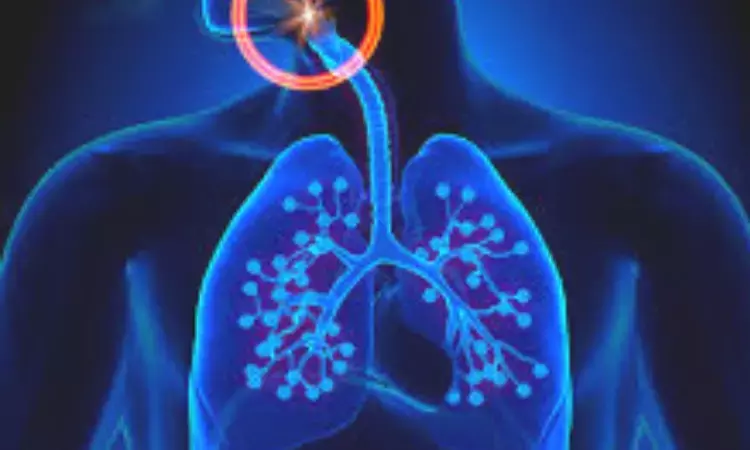- Home
- Medical news & Guidelines
- Anesthesiology
- Cardiology and CTVS
- Critical Care
- Dentistry
- Dermatology
- Diabetes and Endocrinology
- ENT
- Gastroenterology
- Medicine
- Nephrology
- Neurology
- Obstretics-Gynaecology
- Oncology
- Ophthalmology
- Orthopaedics
- Pediatrics-Neonatology
- Psychiatry
- Pulmonology
- Radiology
- Surgery
- Urology
- Laboratory Medicine
- Diet
- Nursing
- Paramedical
- Physiotherapy
- Health news
- Fact Check
- Bone Health Fact Check
- Brain Health Fact Check
- Cancer Related Fact Check
- Child Care Fact Check
- Dental and oral health fact check
- Diabetes and metabolic health fact check
- Diet and Nutrition Fact Check
- Eye and ENT Care Fact Check
- Fitness fact check
- Gut health fact check
- Heart health fact check
- Kidney health fact check
- Medical education fact check
- Men's health fact check
- Respiratory fact check
- Skin and hair care fact check
- Vaccine and Immunization fact check
- Women's health fact check
- AYUSH
- State News
- Andaman and Nicobar Islands
- Andhra Pradesh
- Arunachal Pradesh
- Assam
- Bihar
- Chandigarh
- Chattisgarh
- Dadra and Nagar Haveli
- Daman and Diu
- Delhi
- Goa
- Gujarat
- Haryana
- Himachal Pradesh
- Jammu & Kashmir
- Jharkhand
- Karnataka
- Kerala
- Ladakh
- Lakshadweep
- Madhya Pradesh
- Maharashtra
- Manipur
- Meghalaya
- Mizoram
- Nagaland
- Odisha
- Puducherry
- Punjab
- Rajasthan
- Sikkim
- Tamil Nadu
- Telangana
- Tripura
- Uttar Pradesh
- Uttrakhand
- West Bengal
- Medical Education
- Industry
Daily exposure to mild intermittent hypoxia reduces BP in men with hypertension and sleep apnea

USA: Mild intermittent hypoxia (MIH) brings out beneficial cardiovascular and autonomic outcomes in males with obstructive sleep apnea (OSA) and hypertension, states a recent study. The study appears in the American Journal of Respiratory and Critical Care Medicine.
Intermittent hypoxia, also known as episodic hypoxia, is an intervention in which a person or animal undergoes alternating periods of normoxia and hypoxia.
Jason H. Mateika, John D. Dingell VA Medical Center, Detroit, MI, and colleagues conducted the study with the objective to determine the effect of 15 days of MIH and in-home continuous positive airway pressure treatment on blood pressure in participants with OSA and hypertension.
For this purpose, MIH was administered during wakefulness 5 days/week for 3 weeks. The protocol consisted of twelve 2-minute bouts of hypoxia interspersed with 2 minutes of normoxia.
Throughout the protocol, end-tidal carbon dioxide was maintained 2 mm Hg above baseline values. Control participants were exposed to a sham protocol (i.e., compressed air). Over the 3-week period, treatment of the participants was done with continuous positive airway pressure. The study was completed by sixteen male participants (experimental n = 10; control n = 6).
Based on the study, the researchers reported the following findings:
- Systolic blood pressure at rest during wakefulness over 24 hours was reduced after 15 days of MIH (142.9 ± 8.6 vs. 132.0 ± 10.7 mm Hg), but not following the sham protocol (149.9 ± 8.6 vs. 149.7 ± 10.8 mm Hg). Thus, the reduction in blood pressure from baseline was greater in the experimental group compared with control (−10.91 ± 4.1 vs. −0.17 ± 3.6 mm Hg).
- Modifications in blood pressure were accompanied by increased parasympathetic and reduced sympathetic activity in the experimental group, as estimated by blood pressure and heart rate variability analysis.
- No detrimental neurocognitive and metabolic outcomes were evident following MIH.
To conclude, MIH elicits beneficial cardiovascular and autonomic outcomes in males with OSA and concurrent hypertension.
Reference:
Panza GS, Puri S, Lin HS, Badr MS, Mateika JH. Daily Exposure to Mild Intermittent Hypoxia Reduces Blood Pressure in Male Patients with Obstructive Sleep Apnea and Hypertension. Am J Respir Crit Care Med. 2022 Apr 15;205(8):949-958. doi: 10.1164/rccm.202108-1808OC. PMID: 35015980.
Dr Kamal Kant Kohli-MBBS, DTCD- a chest specialist with more than 30 years of practice and a flair for writing clinical articles, Dr Kamal Kant Kohli joined Medical Dialogues as a Chief Editor of Medical News. Besides writing articles, as an editor, he proofreads and verifies all the medical content published on Medical Dialogues including those coming from journals, studies,medical conferences,guidelines etc. Email: drkohli@medicaldialogues.in. Contact no. 011-43720751


